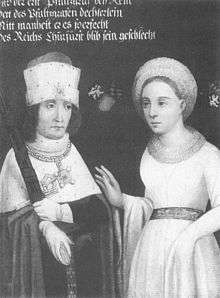Otto II, Duke of Bavaria
Otto II of Bavaria (German: Otto II der Erlauchte, Herzog von Bayern, Pfalzgraf bei Rhein, 7 April 1206 in Kelheim – 29 November 1253) known as Otto the Illustrious was the Duke of Bavaria and Count Palatine of the Rhine (see Electorate of the Palatinate). He was the son of Ludwig I and Ludmilla of Bohemia and a member of the Wittelsbach dynasty.
Otto II Wittelsbach, Duke of Bavaria | |
|---|---|
 Portrait from Die Chronik Bayerns | |
| Born | 7 April 1206 Kelheim |
| Died | 29 November 1253 (aged 47) Landshut |
| Buried | Crypt of Scheyern Abbey |
| Noble family | Wittelsbach |
| Spouse(s) | Agnes of the Palatinate |
| Issue | |
| Father | Louis I Wittelsbach, Duke of Bavaria |
| Mother | Ludmilla of Bohemia |

Life
Otto was born at Kelheim.
At the age of sixteen, he was married to Agnes of the Palatinate, a granddaughter of Duke Henry the Lion and Conrad of Hohenstaufen. With this marriage, the Wittelsbach inherited the Palatinate and kept it as a Wittelsbach possession until 1918. Since that time also the lion has become a heraldic symbol in the coat of arms for Bavaria and the Palatinate.
Otto acquired the rich regions of Bogen in 1240, and Andechs and Ortenburg in 1248 as possessions for the Wittelsbach and extended his power base in Bavaria this way. With the county of Bogen the Wittelsbach acquired also the white and blue coloured lozenge flag which since that time has been the flag of Bavaria (and of the Palatinate).
After a dispute with emperor Frederick II was ended, he joined the Hohenstaufen party in 1241. His daughter, Elizabeth, was married to Frederick's son Conrad IV. Because of this, Otto was excommunicated by the pope.
He died in Landshut in 1253. Like his forefathers, Otto was buried in the crypt of Scheyern Abbey.
Family and children
Otto married Agnes, the daughter of Henry V, Count Palatine of the Rhine (a son of Henry the Lion) and Agnes of Hohenstaufen, in Worms in 1222. Their children were:
- Ludwig I, Duke of Upper Bavaria (13 April 1229, Heidelberg – 2 February 1294, Heidelberg).
- Henry I, Duke of Lower Bavaria (19 November 1235, Landshut – 3 February 1290, Burghausen.
- Elisabeth of Bavaria, Queen of Germany (c. 1227, Landshut – 9 October 1273), married to:
- September 1246[1] in Vohburg to Conrad IV of Germany;
- 1259 in Munich to Count Meinhard II of Gorizia-Tyrol, Duke of Carinthia.
- Sophie (1236, Landshut – 9 August 1289, Castle Hirschberg), married 1258 to Count Gerhard IV of Sulzbach and Hirschberg.
- Agnes (c. 1240–c. 1306), Nun in Segenstal Abbey
Ancestors
| Ancestors of Otto II, Duke of Bavaria | ||||||||||||||||||||||||||||||||||||||||||||||||||||||||||||||||||||||||||||||||||||||||||||||||||||||||||||||||||||||||||||||||||||||||||||||||||||||||||||||||||||||||||||||||||||||||||||||||||||||||||||||||||||||||||||||||||||||||||||||||||||||||||||||||||||||||||||||||||||||||||||||||||||||||||||||||||||||||||||||||||||||||||||||||||||||||||||||||||||||||||||||||||||||||||||||||||||||||||||||||||||||||||||||||||||||||||||||||||||||||||||||||||||||||||||||||||||||||||||||||||||||||||||||||||||||||||||||||||||||||||||||||||||||||||||||||||||||||||||||||||||||||||||||||||||||||||||||||
|---|---|---|---|---|---|---|---|---|---|---|---|---|---|---|---|---|---|---|---|---|---|---|---|---|---|---|---|---|---|---|---|---|---|---|---|---|---|---|---|---|---|---|---|---|---|---|---|---|---|---|---|---|---|---|---|---|---|---|---|---|---|---|---|---|---|---|---|---|---|---|---|---|---|---|---|---|---|---|---|---|---|---|---|---|---|---|---|---|---|---|---|---|---|---|---|---|---|---|---|---|---|---|---|---|---|---|---|---|---|---|---|---|---|---|---|---|---|---|---|---|---|---|---|---|---|---|---|---|---|---|---|---|---|---|---|---|---|---|---|---|---|---|---|---|---|---|---|---|---|---|---|---|---|---|---|---|---|---|---|---|---|---|---|---|---|---|---|---|---|---|---|---|---|---|---|---|---|---|---|---|---|---|---|---|---|---|---|---|---|---|---|---|---|---|---|---|---|---|---|---|---|---|---|---|---|---|---|---|---|---|---|---|---|---|---|---|---|---|---|---|---|---|---|---|---|---|---|---|---|---|---|---|---|---|---|---|---|---|---|---|---|---|---|---|---|---|---|---|---|---|---|---|---|---|---|---|---|---|---|---|---|---|---|---|---|---|---|---|---|---|---|---|---|---|---|---|---|---|---|---|---|---|---|---|---|---|---|---|---|---|---|---|---|---|---|---|---|---|---|---|---|---|---|---|---|---|---|---|---|---|---|---|---|---|---|---|---|---|---|---|---|---|---|---|---|---|---|---|---|---|---|---|---|---|---|---|---|---|---|---|---|---|---|---|---|---|---|---|---|---|---|---|---|---|---|---|---|---|---|---|---|---|---|---|---|---|---|---|---|---|---|---|---|---|---|---|---|---|---|---|---|---|---|---|---|---|---|---|---|---|---|---|---|---|---|---|---|---|---|---|---|---|---|---|---|---|---|---|---|---|---|---|---|---|---|---|---|---|---|---|---|---|---|---|---|---|---|---|---|---|---|---|---|---|---|---|---|---|---|---|---|---|---|---|---|---|---|---|---|---|---|---|---|---|---|---|---|---|---|---|---|---|---|---|---|---|---|---|---|---|---|---|---|---|---|---|---|---|---|---|---|---|---|---|---|---|---|---|---|---|---|---|---|---|---|---|---|---|---|---|---|---|---|---|---|---|---|---|---|---|---|---|---|---|---|---|---|---|---|---|---|---|---|---|---|---|---|---|---|---|---|---|---|---|---|---|---|---|---|---|---|---|---|---|---|---|---|---|---|---|---|---|---|---|---|---|---|---|---|---|---|---|---|---|---|---|---|---|---|---|---|---|---|---|---|---|---|---|---|---|---|---|---|---|---|---|---|---|---|---|---|---|
| ||||||||||||||||||||||||||||||||||||||||||||||||||||||||||||||||||||||||||||||||||||||||||||||||||||||||||||||||||||||||||||||||||||||||||||||||||||||||||||||||||||||||||||||||||||||||||||||||||||||||||||||||||||||||||||||||||||||||||||||||||||||||||||||||||||||||||||||||||||||||||||||||||||||||||||||||||||||||||||||||||||||||||||||||||||||||||||||||||||||||||||||||||||||||||||||||||||||||||||||||||||||||||||||||||||||||||||||||||||||||||||||||||||||||||||||||||||||||||||||||||||||||||||||||||||||||||||||||||||||||||||||||||||||||||||||||||||||||||||||||||||||||||||||||||||||||||||||||
References
- Citations
- Bachrach 2014, pp 138
- Bibliography
- Arnold, Benjamin (1985). German Knighthood 1050 - 1300. Oxford: Clarendon Press. ISBN 0-19-821960-1.
- Arnold, Benjamin (1991). Count and Bishop in Medieval Germany: A Study of Regional Power, 1100 - 1350. Pennsylvania: University of Pennsylvania Press.
- Arnold, Benjamin (1991). Princes and territories in medieval Germany. Cambridge: Cambridge University Press. ISBN 0-521-39085-0.
- Bachrach, David S. (2016). The Histories of a Medieval German City, Worms c. 1000-c.1300. New York: Routledge. ISBN 9781472436412.
- Holzfurtner, Ludwig (2005). Die Wittelsbacher: Staat und Dynastie in acht Jahrhunderten (Urban-Taschenbucher). Kohlhammer Verlag. ISBN 978-3170181915.
- Hubensteiner, Benno (2013). Bayerische Geschichte. Munich: Rosenheimer Verlagshaus. ISBN 978-3475537561.
- Stevens, John (1706). The History of Bavaria: From the First Ages, to This Present Year.
- Peltzer, Jörg (2013). Die Wittelsbacher und die Kurpfalz im Mittelalter: Eine Erfolgsgeschichte?. Schnell & Steiner. ISBN 978-3795426453.
- Reiss-Engelhorn-Museen, Mannheim (2013). Die Wittelsbacher am Rhein. Die Kurpfalz und Europa: 2 Bände. Schnell & Steiner. ISBN 978-3795426446.
- Schmid, Gregor M. (2014). Die Familie, die Bayern erfand: Das Haus Wittelsbach: Geschichten, Traditionen, Schicksale, Skandale. Munich: Stiebner. ISBN 978-3830710608.
- Vogel, Susanne (2012). Die Wittelsbacher: Herzöge - Kurfürsten - Könige in Bayern von 1180 bis 1918. Biografische Skizzen. Staackmann. ISBN 978-3886752485.
Otto II, Duke of Bavaria Born: 1206 Died: 1253 | ||
| German royalty | ||
|---|---|---|
| Preceded by Ludwig I |
Duke of Bavaria 1231-1253 |
Succeeded by Ludwig II and Henry XIII |
| Count Palatine of the Rhine 1228–1253 |
Succeeded by Ludwig II | |